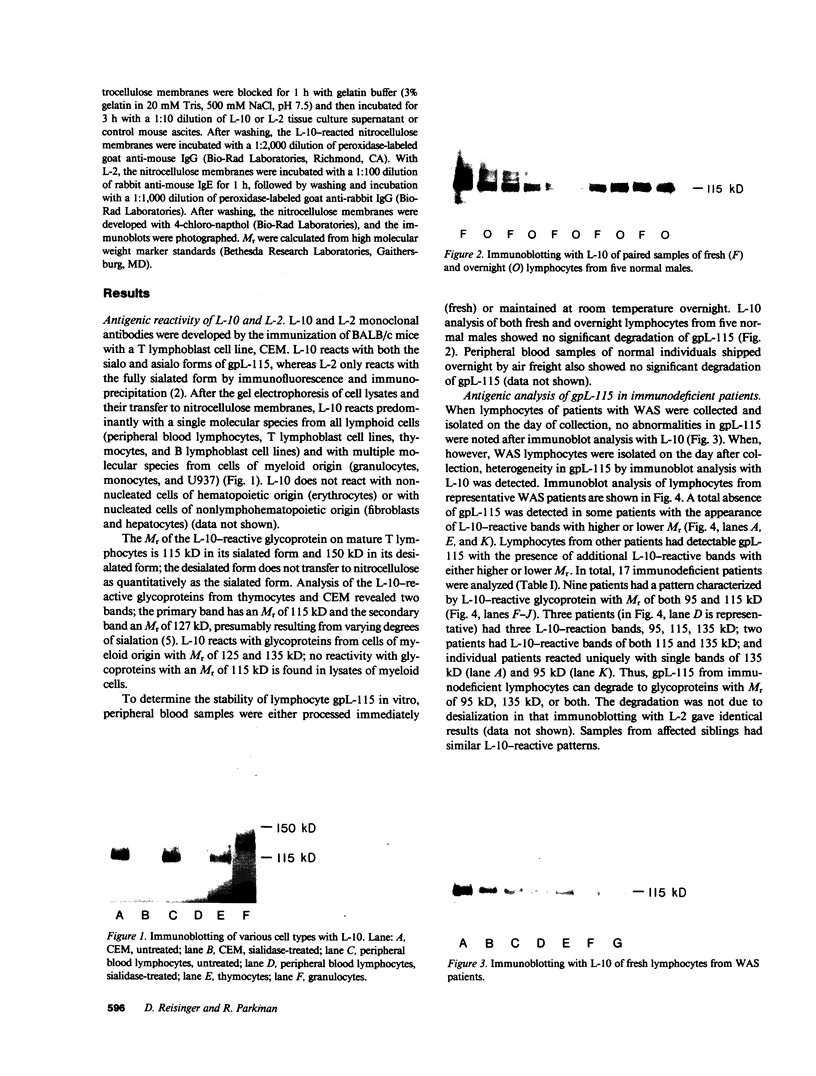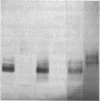Abstract
Previous evaluation of lymphocytes taken from patients with Wiskott-Aldrich syndrome (WAS) and other X-linked immunodeficiencies has revealed deficiencies of a lymphocyte sialoglycoprotein with a relative molecular mass of 115 kD (designated gpL-115) found in normal lymphocytes. The development of monoclonal antibodies to gpL-115 has permitted the detection of molecular heterogeneity in gpL-115 from the lymphocytes of immunodeficient patients. When lymphocytes from normal individuals were analyzed by immunoblotting, gpL-115 with only a single molecular species (115 kD) was detected. Lymphocytes from 17 immunodeficient patients were analyzed after overnight incubation. Two patients had no gpL-115 with an Mr of 115 kD, but gpL-115 with an Mr of either 95 or 135 kD was detected. Nine patients had gpL-115 with Mr equally of 95 and 115 Kd. Other patients exhibited gpL-115 with combinations of 95, 115, and 135 kD. The heterogeneity of the degraded gpL-115 suggests that WAS and other X-linked immunodeficiencies are due to a series of abnormalities, all of which involve gpL-115, and may explain the clinical heterogeneity of the diseases.
Full text
PDF




Images in this article
Selected References
These references are in PubMed. This may not be the complete list of references from this article.
- Axelsson B., Hammarström S., Finne J., Perlmann P. The large sialoglycoprotein of human lymphocytes. II. Biochemical features. Eur J Immunol. 1985 May;15(5):427–433. doi: 10.1002/eji.1830150503. [DOI] [PubMed] [Google Scholar]
- Axelsson B., Hammarström S., Robertsson E. S., Aman P., Perlmann P., Mellstedt H. The large sialoglycoprotein of human lymphocytes. I. Distribution on T and B lineage cells as revealed by a monospecific chicken antibody. Eur J Immunol. 1985 May;15(5):417–426. doi: 10.1002/eji.1830150502. [DOI] [PubMed] [Google Scholar]
- Brown W. R., Barclay A. N., Sunderland C. A., Williams A. F. Identification of a glycophorin-like molecule at the cell surface of rat thymocytes. Nature. 1981 Feb 5;289(5797):456–460. doi: 10.1038/289456a0. [DOI] [PubMed] [Google Scholar]
- Kenney D., Cairns L., Remold-O'Donnell E., Peterson J., Rosen F. S., Parkman R. Morphological abnormalities in the lymphocytes of patients with the Wiskott-Aldrich syndrome. Blood. 1986 Dec;68(6):1329–1332. [PubMed] [Google Scholar]
- O'Farrell P. H. High resolution two-dimensional electrophoresis of proteins. J Biol Chem. 1975 May 25;250(10):4007–4021. [PMC free article] [PubMed] [Google Scholar]
- Parkman R., Rappeport J., Geha R., Belli J., Cassady R., Levey R., Nathan D. G., Rosen F. S. Complete correction of the Wiskott-Aldrich syndrome by allogeneic bone-marrow transplantation. N Engl J Med. 1978 Apr 27;298(17):921–927. doi: 10.1056/NEJM197804272981701. [DOI] [PubMed] [Google Scholar]
- Parkman R., Remold-O'Donnell E., Cairns L., Rappeport J. M., Cowan M., Ammann A., Kenney D., Potter N., Rosen F. S. Immune abnormalities in patients lacking a lymphocyte surface glycoprotein. Clin Immunol Immunopathol. 1984 Dec;33(3):363–370. doi: 10.1016/0090-1229(84)90307-6. [DOI] [PubMed] [Google Scholar]
- Parkman R., Remold-O'Donnell E., Kenney D. M., Perrine S., Rosen F. S. Surface protein abnormalities in lymphocytes and platelets from patients with Wiskott-Aldrich syndrome. Lancet. 1981 Dec 19;2(8260-61):1387–1389. doi: 10.1016/s0140-6736(81)92802-6. [DOI] [PubMed] [Google Scholar]
- Remold-O'Donnell E., Kenney D. M., Parkman R., Cairns L., Savage B., Rosen F. S. Characterization of a human lymphocyte surface sialoglycoprotein that is defective in Wiskott-Aldrich syndrome. J Exp Med. 1984 Jun 1;159(6):1705–1723. doi: 10.1084/jem.159.6.1705. [DOI] [PMC free article] [PubMed] [Google Scholar]








